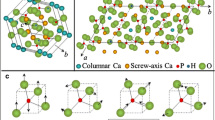Summary
A preliminary investigation of electric dipole reorientability in human tooth enamel (TE) in comparison to that in hydroxyapatite (OHAp) has been made with the fractional-polarization form of the thermally stimulated currents (TSC) method. The reorientable dipoles are the structural OH− ions. The OHAp exhibited compensation phenomena at 211.5°C and at 356°C which are associated here with the hexagonal form becoming quasi-statically stabilized and dynamically stabilized, respectively, against the monoclinic form. TE specimens were pretreated at various temperatures. All showed the onset of cooperative motions that could quasi-statically stabilize the hexagonal form at the same temperature, approximately 212°C, as did OHAp, even though the TE was already statically stabilized in the hexagonal form. Parts of the TSC spectra that did not conform to the 212°C compensation changed progressively with pretreatment temperature. Loss of incorporated H2O is identified as the most probable cause of most of these changes. This work shows considerable promise for TSC as a tool for further quantitative investigation of TE.
Similar content being viewed by others
References
Zielinski M, Kryszewski M (1977) Thermal sampling technique for the thermally stimulated discharge in polymers. Model calculations. Phys Status Solidi (a) 42:305–314
Dreyfus G, LaCabanne C, Rahal A (1978) Cables a courant continu a isolation synthétique extrudée. Méthode des courants thermostimulés. Revue Générale de l'Electricité 87:870–880
Hitmi N, LaCabanne C, Young RA (1984) TSC study of electric dipole relaxations in chlorapatite. J Phys Chem Solids 45:701–708
Featherstone JDB (1983) Diffusion phenomena and enamel caries development. Cariology Today. Int'l Congress Zurich, pp 259–268
Arends J, Van Der Berg PJ, Jongebloed WL (1975) Dissolution of hydroxyapatite and fluorapatite single crystals. Colloque International CNRS, No 230 Physico-Chimie et Crystallographie des Apatites d'Intérêt Biologique, CNRS, Paris, pp 389–395
Langdon D, Dykes E, Fernhead RW (1975) Defects, diffusion and dissolution in biological and synthetic apatite. Colloque International CNRS, No 230 Physico-Chimie et Crystallographie des Apatites d'Intérêt Biologique, CNRS, Paris, pp 381–388
Kay MI, Young RA, Posner AS (1964) Crystal structure of hydroxyapatite. Nature 204:1050–1052
Sudarsanan K, Young RA (1969) Significant precision in crystal structural details: Holly Springs hydroxyapatite. Acta Cryst B25:1534–1544
Young RA, Sudarsanan K, Mackie PE (1968) Structural origin of some physical property differences among three apatites. Bulletin de la Société Chimique de France (no special) 1760–1763
Mackie PE, Elliott JC, Young RA (1972) Monoclinic structure of synthetic chlorapatite. Acta Cryst B28:1840–1848
Mackie PE, Elliott JC, Young RA (1973) Monoclinic hydroxyapatite. Science 180:1055–1057
Young RA (1975) Some aspects of crystal structural modeling of biological apatites. Colloques International CNRS No 230 Physico-Chimie et Cristallographie des Apatites d'Interet Biologique, Paris, pp 21–39
Young RA (1980) Large effects from small structural differences in apatites. Proc 2nd Intl Conf Phosphorus Compounds, (April 21–25, 1980, Boston) Institut Mondial du Phosphate, Paris pp 73–88
Young RA, Holcomb DW (1982) Variability of hydroxyapatite preparations. Calcif Tissue Int 34:S17-S32
Trombe JC (1972) Contribution a l'étude de la decomposition et de la reactivité de certaines apatites hydroxylées, carbonatées ou fluorées alcalino-terreuses, theśe. Université Paul Sabatier, Toulouse
Young RA, Wiles DB, (1981) Application of the Rietveld method for structure refinement with powder diffraction data. Advances in x-ray analysis 24:1–23
Mackie PE, Young RA (1980) Crystallography of human tooth enamel: initial structure refinement. Mat Res Bull 15:17–29
Young RA (1974) Implications of atomic substitutions and other structural detail in apatites. J Dent Res 53:193–199
Curzon MEJ, Cutress TW, eds (1983) Trace elements and dental disease. John Wright and Sons, Bristol
Chatain D (1974) Contribution á l'étude des propriétées dielectriques des polyamides, thèse. Université Paul Sabatier, Toulouseh
Zielinski M, Swiderski T, Kryszewski M (1978) Thermal sampling in polymers with distributed relaxations: PMMA. Polymers 19:883–888
Peacock-Lopez E, Suhl H (1982) Compensation effect in thermally activated processes. Phys Rev B 26:3774–3782
Hitmi N (1983) Etude des transitions dans les composantes minerale et organique des tissues calcifiés par spectroscopie dielectrique basse frequence, thèse. Université Paul Sabatier, Toulouse
Hitmi N, Chatain D, LaCabanne C, Dugas J, Trombe JC, Rey C, Montel G (1980) TSC study of dipolar reorientations in hydroxyapatites. Solid State Communications 33:1003–1004
Van Rees HB, Mengeot M, Kostiner E (1973) Monoclinic-hexagonal transition in hydroxyapatite and deuterohydroxyapatite single crystals. Mat Res Bull 8:1307
Freund F, Knobel RM (1977) Distribution of fluorine in hydroxyapatite studied by infrared spectroscopy. J Chem Soc (Dalton) 1136–1140
Young RA, Van der Lugt W, Elliott JC (1969) Mechanism for fluorine inhibition of diffusion in hydroxyapatite. Nature 223:729–730
Lines ME, Glass AM (1977) Principles and applications of ferroelectrics and related materials. Clarendon Press, Oxford
Rausch EO (1976) Dielectric properties of chlorapatite, thesis. Georgia Institute of Technology
Holcomb DW, Young RA (1980) Thermal decomposition of human tooth enamel. Calcif Tissue Int 31:189–201
Lamure-Plaino E (1985) Etude des reorientations dipolaires dans l'email dentaire humain mature par spectroscopie dielectrique, thèse. Université Paul Sabaiter, Toulouse
Young RA, Bartlett ML, Spooner S, Mackie PE, Bonel G (1981) Reversible high temperature exchange of carbonate and hydroxyl ions in tooth enamel and synthetic hydroxyapatite. J Biol Phys 9:1–34
Little MF, Casciani FS (1966) The nature of water in sound human enamel A preliminary study. Arch Oral Biol 11:565–571
Holcomb DW, Young RA (1984) Role of acid phosphate in hydroxyapatite lattice expansion. Calcif Tissue Int 36:60–63
Arends J, Davidson CL (1975) HPO 2−4 content in enamel and artificial carious lesions. Calcif Tissue Res 18:65–79
Hitmi N, LaCabanne C, Bonel G, Young RA (1986) Dipole cooperative motions in an A-type carbonated apatite, Sr10(ASO4)6 CO3. J Phys Chem Solids (in press)
Dibdin GH (1972) The stability of water in human dental enamel. Studies by proton nuclear magnetic resonance. Archs Oral Biology 17:433–437
Author information
Authors and Affiliations
Rights and permissions
About this article
Cite this article
Hitmi, N., Lamure-Plaino, E., Lamure, A. et al. Reorientable electric dipoles and cooperative phenomena in human tooth enamel. Calcif Tissue Int 38, 252–261 (1986). https://doi.org/10.1007/BF02556603
Received:
Revised:
Issue Date:
DOI: https://doi.org/10.1007/BF02556603



